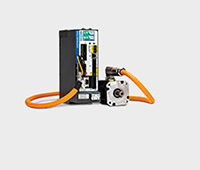Research into high-temperature semiconductors is yielding integrated circuits able to operate at temperatures close to those at which natural gas burns.
Mehran Mehregany is the Veale Professor of Engineering Innovation at Case Western Reserve University, Director of the Case School of Engineering San Diego, and Editor of a recent book titled “Wireless Health: Remaking of Medicine by Pervasive Technologies.”
Srihari Rajgopal is a Research Associate in the Department of Electrical Engineering and Computer Science of Case Western Reserve University.
Someday, the bulky substation transformers that spread power from the utility grid to local neighborhoods could become a thing of the past. That’s because semiconductor devices made from silicon carbide (SiC) could remake the grid. The reason: Silicon carbide ICs and electronic components can operate at temperatures far higher than ordinary silicon-based semiconductors and handle electrical current more efficiently.
Besides restructuring the utility grid, SiC power devices could also revolutionize solar and wind energy creation by reducing the amount of energy lost during the uploading of power to the grid. And SiC ICs’ ability to operate at super-high temperatures may be one of the technologies that make hypersonic planes feasible.
To understand why SiC devices can handle high currents and temperatures, consider the behavior of a transistor. It acts as a switch that routes current. Any transistor leaks a small amount of current, and as the ambient temperature rises, so does the leakage current. At some temperature point, this leakage is large enough to compromise the circuit. This leakage is in big part determined by an intrinsic material property—the bandgap. The wider the semiconductor material’s bandgap, the higher the temperature point to which the leakage is acceptable.
SiC has a bandgap ~2.6x that of Si, making it particularly well suited for high temperature electronics. Other factors also contribute to making SiC a leading candidate for high temperature ICs. The commercial drivers for SiC have been in the fabrication of light emitting diodes and high-power electronics (for power conversion and motor control). These commercial thrusts have resulted in better wafer quality with fewer defects, as well as advances in processing technology, such as doping, etching and electrical contacts.
Circuits based on the junction field-effect transistor (JFET) are the most technologically mature in SiC high temperature electronics. AT CWRU, we have designed, fabricated and tested several JFET-based circuits on what’s called 6H-SiC, a specific crystal form (or polytype) of SiC, to 600° C. (Ordinary silicon ICs are typically capable of operation to ~85° C)

Figure-1–Optical-photo-of-the-6H-SiC-IC-chip
Figure 1 is an optical photo of a 6H-SiC chip with basic JFETs and circuits like differential pairs, single-stage amplifiers, two-stage amplifiers, transimpedance amplifiers, and digital logic blocks like NAND, NOR and inverter. Figure 2a is an optical photo of the single-stage amplifier for which the ac response is shown in Fig. 2b. The variation in the differential voltage gain from room temperature up to 450° C is less than 1.4 dB.

Figure-2a–Optical-photo-of-a-single-stage-amplifier-with-current-source-load-and-a-cascoded-driver

Figure-2b–Measured-differential-mode-gain-of-Fig.-2a-type-amplifier-at-various-temperatures
Filed Under: Commentaries • insights • Technical thinking, MOTION CONTROL





Tell Us What You Think!